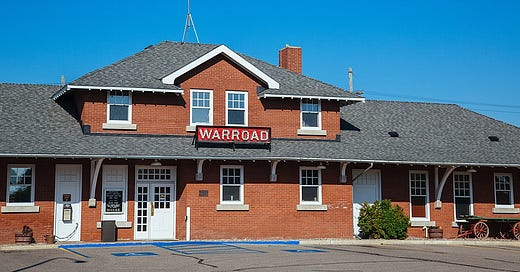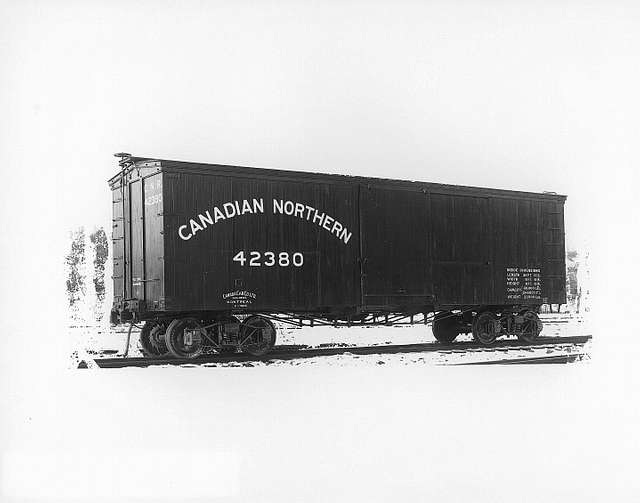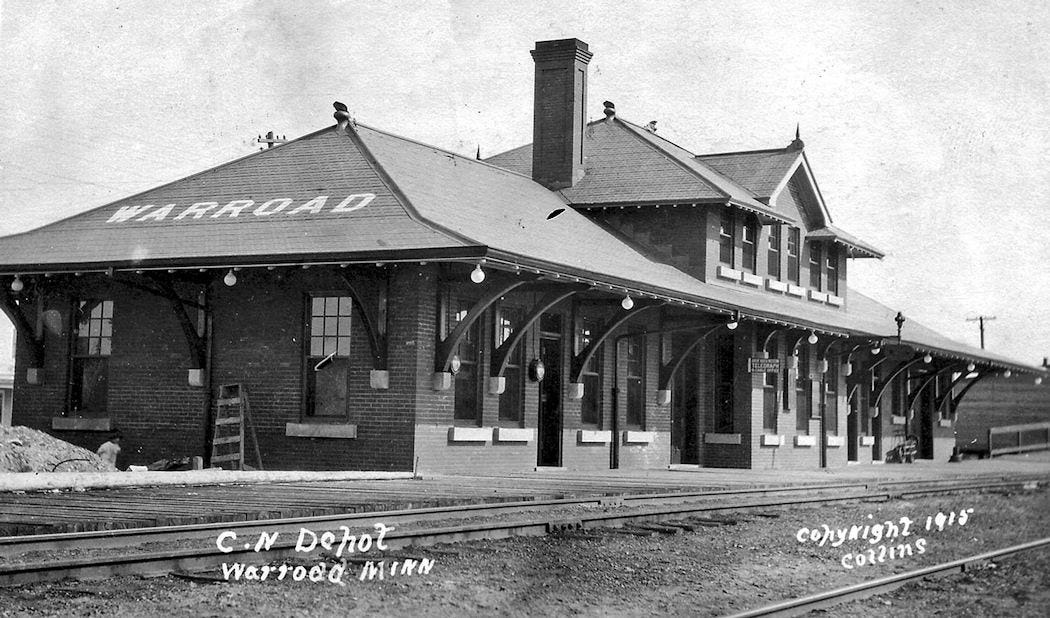Trains still set the rhythm and pace to daily life in Warroad. The ding-ding-ding, flashing red lights, and gates dropping across Lake Street happens 20 or more times a day. Every day.
Locomotives pulling flatcars loaded with shipping containers speed down the tracks — the ground rumbles, the tracks clack, metal screeches, horns blare. The trains don’t slow down.
No passenger trains stop at the depot anymore. July 30, 1977, was the last time.
The first time the Canadian Northern Railway stopped in Warroad, Minnesota, was on February 16, 1900. The township of Warroad had been incorporated in 1895 by white settlers in the Ojibway village of Kah-bay-kah-nong. The following year Warroad was annexed into Roseau County. It officially became a city in 1901.
Until the railroads arrived, the waterways had been the primary mode of transportation. From Lake of the Woods — to the north into the Hudson Bay or east along the Rainy River to Lake Superior — the lakes, rivers, and streams were the routes for travel and European fur traders successfully navigated them for at least two centuries.
Canadian Northern Railway built the original train depot near its present location on the corner of Main Avenue and Mackenzie Street. The train station also served as a telegraph office.
Trains traveled east to Lake Superior with connections to the Atlantic Ocean; to the west the tracks would extend all the way to Vancouver by 1915. The forty some miles of train tracks from Warroad southeast to Baudette on the Minnesota side of Lake of the Woods was the only segment of the Canadian Northern Railway to run across US soil.
In 1901, a railroad bridge across the Warroad River was built. Commercial fishing boomed with the introduction of rail transportation. Three fisheries were located in close proximity to the train tracks downtown.1
It was July 15, 1914, when embers from a coal-burning engine ignited the wooden structure of the train depot and burned it to the ground.
Immediately after the fire, Canadian Northern Railway assigned architect John Schofield to design a new brick depot. Construction began in September of 1914 for a total cost of $30,000.
The station master’s living quarters were on the second floor and the ticket and railroad offices were immediately below. At one end there was a waiting room and at the other, a room for baggage handling.
Until the 1930’s, immigration offices were housed in the corner of the waiting room. Beginning in 1900, large numbers of European emigrants traveled across Ontario on the transcontinental train through Warroad on their way west where they settled in Manitoba, Alberta, Saskatchewan and British Columbia.
When the passenger trains stopped running in 1977, Canadian National Railway maintained the building, intending to move it north to Canada. Many area residents did not want to let this local landmark go and city officials began to explore how they might preserve it in its original location.
In 1980, Governor Quie of Minnesota signed a bill making the Canadian Northern Depot in Warroad a state historical site. The City of Warroad also completed the forms for recognition of the depot as a national historic site.
In December of 1981, the Marvin family of Warroad donated $25,000 toward the purchase and renovation of the depot by the city. It went on the National Registry of Historic Places in 1982.
The City of Warroad then purchased the building from Canadian National Railway and renovations began in 1983. They kept the original window sashes and casings, solid oak doors, counters and built-in woodwork. The public washroom doors are the originals.
The train depot reopened in 1985. It remains a local landmark and continues to house city government offices.
Brady Swanson, director of the Warroad Heritage Center, “History of Fishing on Lake of the Woods,” presentation on May 9, 2024 at the Lake of the Woods Brewery, Warroad, MN.







I was awed with the presentation by Brady Swanson about the fishing history - if I was teaching about how to deliberate about a public policy issue, one assignment would be to watch this video - he covered so much - the ecological issues, the industrial issues, the varying views about commercial and sports fishing, and on and on. I liked the way he moved across the time periods. Also, I think he would be a great moderator, because he was able to identify the tensions without himself taking sides. In addition, I just learned so many things about fishing that I didn't know. The poor sturgeons! And I had no knowledge about the intersection of fishing with mink farming. Geez!
Jill- Such interesting chronicles. My favorite part is when you described how the station master’s quarters are on the top floor. I’ve learned recently as well that this is how restaurants begun in the west as well: in train stations. A wonderful read!